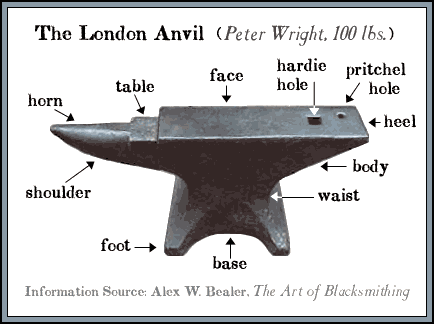
The Blacksmith’s Anvil
A blacksmith is described as the person who forges metal by bending, hammering and cutting it in order to make various items using wrought iron or steel. Some of the tools used by a blacksmith include hammers, tongs and the blacksmith’s anvil among others and the items produced include agricultural implements, furniture, weapons, cooking utensils and railings.
The blacksmith’s anvil is a tool mainly used for forging and though most anvils are made using steel, different types also exist. An anvil is a basic tool that is made of a block of steel with a very hard surface upon which other objects are struck.
The anvil block is made as massive as is practically possible. The reason for this is, the higher the anvil’s rebound capability, the more efficient the energy of the striking tool will be when it is transferred to the piece that is being worked on.
The anvil face: Primarily, the working surface of the blacksmith’s anvil is known as the face. It is generally tempered and hardened to be able to resist the blows of the blacksmith’s hammer. This keeps it from getting deformed when used repeatedly and also minimizes the amount of force necessary that needs to be used for each blow of the hammer. The face of the anvil should never receive a direct blow from the hammer as it may damage the brittle steel. The face of the anvil is made from hardened steel and it should be flat, smooth and should have rounded edges for it to be suitable for most of the work. Any marks that are made on the face of the anvil will be transferred to the work.
The anvil horn (also referred to as the “beak”): The horn is a projection at one end of the anvil that is conical in shape, and made from unhardened iron or steel. It is mainly used to form items that require round shapes. The horn is generally used in operations where bending is required, or as an aid in making the stock thinner and longer (drawing down the stock). Some horns are made with clips or side horns for fabricating different types of specialized work; others are made with two horns, one of them being square and the other being round.The pritchel: The pritchel hole is basically a round, small hole found on most anvils that are used today, with some anvils having more than one pritchel hole. It is mostly used for punching and a second tool called a swage can be fitted into the hole to enable the blacksmith to have more flexibility when there is need for the use of more anvil tools.
The anvil ledge: The ledge is the soft area that is found between the ‘face’ and the ‘horn’ of the anvil. The ledge is mainly used for cutting operations. The use of the ledge is preferable to using the face, for any work involving cutting, since this prevents damage to the face of the anvil.
The hardie hole: A hardie hole is basically a square hole located in the back of the anvil where the cutting and specialized forming tools are placed (also known as the hardie tools). It can also be used in bending and cutting operations.